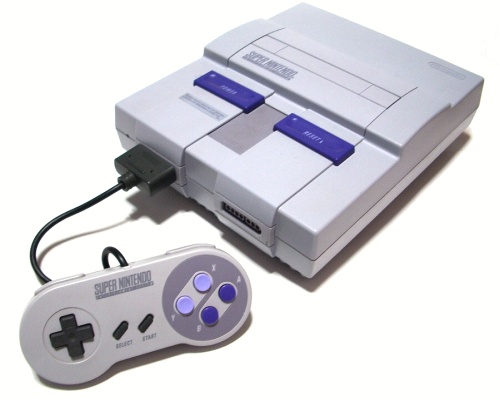Optimal Hardware:
The Super Nintendo
|
2 December 2012
The Super Nintendo dominated the 16-bit era—despite a very lively competition with the Sega Genesis—and still has one of the finest RPG libraries you'll ever find. This was, after all, Square's last gasp before abandoning Nintendo (and returning much later with the arrival of the Wii). You'll also find Kirby, Mega Man, Lost Vikings, and Street Fighters—all in fine form. But who am I convincing? Wanting a SNES is a no-brainer. Here's your guide to finding the best hardware to fit your needs.
#1 — Original North American SNES
Not only is this console design a vast improvement—go top-loading cartridges!—over the NES "toaster," but Nintendo even included S-video output, something that's sorely missing on all the other consoles of the 16-bit era (we'll ignore the Japan-only Sega Wondermega, because they're crazy rare and expensive). You even have an eject button. Thanks to plentiful supply—winning the 16-bit console war helps—you can easily find this SNES for short money and the S-video cable is also readily available. |
 |
|
|
|
|
|
It's a great, compact system, and the biggest complaint is that the grey plastic is prone to yellowing over time. That you're forced to delve into such issues as the color of plastic in order to criticize this console demonstrates how fundamentally sound the design is. Fortunately, you can easily cure a jaundiced SNES, as shown in this video:
SNES games are region-locked, so there's a big difference between the North American, PAL, and Japanese models. In general, you can't argue with the American model. The PAL game library is much smaller (and usually more expensive) than its U.S. and Japanese counterparts, and there's a high probability that you won't properly enjoy the fantastic SNES RPG library if all the text is in Japanese (and if you do understand Japanese, then you're obviously the exception and I'm very jealous of your skills). Should you want to venture into games outside your console's region, though, there are numerous cartridge adapter solutions. Speaking of import titles, the next entry on our list offers some unique built-in benefits... |
#2 — Retro Duo
As has already been covered in the NES hardware guide, what you have here remains one of the finest console clones ever created. To date, it doesn't have any serious rivals. Not only does it do a tremendous job handling SNES games, but being able to play NES carts is a hell of a bonus. |
Whereas playing NES games is dependent on numerous annoying caveats, you're looking golden for 16-bit titles:
--Original SNES controllers plug in without a problem
--Full support for almost all American, PAL, and Japanese carts (check compatability here)
--SNES audio sounds remarkably true to the original SNES hardware
--The Retro Duo even works with Super Game Boy
|
You have both composite and S-video output, but what's extra cool is that you don't need any special sort of SNES S-video cable, a standard male-to-male S-video cable will do the job perfectly. The Retro Duo is a fantastic console, overall, but it is a little annoying that you'll pay more for it (about $50+) than a used original SNES. Nevertheless, if you're looking for a quick and easy solution to play SNES games from all regions this is what it's all about.
|
#3 — SNS-101 (aka SNES 2 / SNES Mini, SNES Jr.)
Released in North America in 1997, Nintendo may have tried to market this like it was identical to the original model, butwith a new bargain price you know there has to be some sort of catch... |
...and the catch is that there is NO S-VIDEO support. In a bizarre twist of fate, the video coder inside still supports S-video and RGB, but the pins are left unused. You better be a fan of modding if getting the best video output with this version of the hardware is your goal.
Other corners were cut, too, like ditching the cartridge eject button and not bothering with an LED light to indicate that the power is on. You won't find an RF connection, either, but surely you don't care about that, right?
In short, going this route can only be recommended if you want to play your games on an old TV that lacks S-Video input and you aren't interested in import cartridges. Obviously, that's a pretty specific set of circumstances, and when you take into account resale value and appealing to a broader audience you're still going to be much better off with the #1 or #2 option above.
Conclusion
The SNES is one of the greatest pieces of hardware ever created. It remains incredibly rugged and durable. It's sound capabilities often shamed the early Playstation One releases. If you're going to delve into real games of the era, that requires real hardware and this is a fantastic place to start, whether you like the ultra-original approach or the new-school flexability provided by a clone, which brings us to an odd ending of sorts: an appeal to Nintendo...
BIG N. I love you. All us retro gamers love you. No one will ever match what you did in the 8- and 16-bit golden era of gaming. The Retro Duo is great, but it could be even better. You could do it even better. Not only that, but we'd be delighted to buy your official, amazing, updated NES and SNES combo console. You just have to make it. Make it and we'll be there to buy it. |
|
|